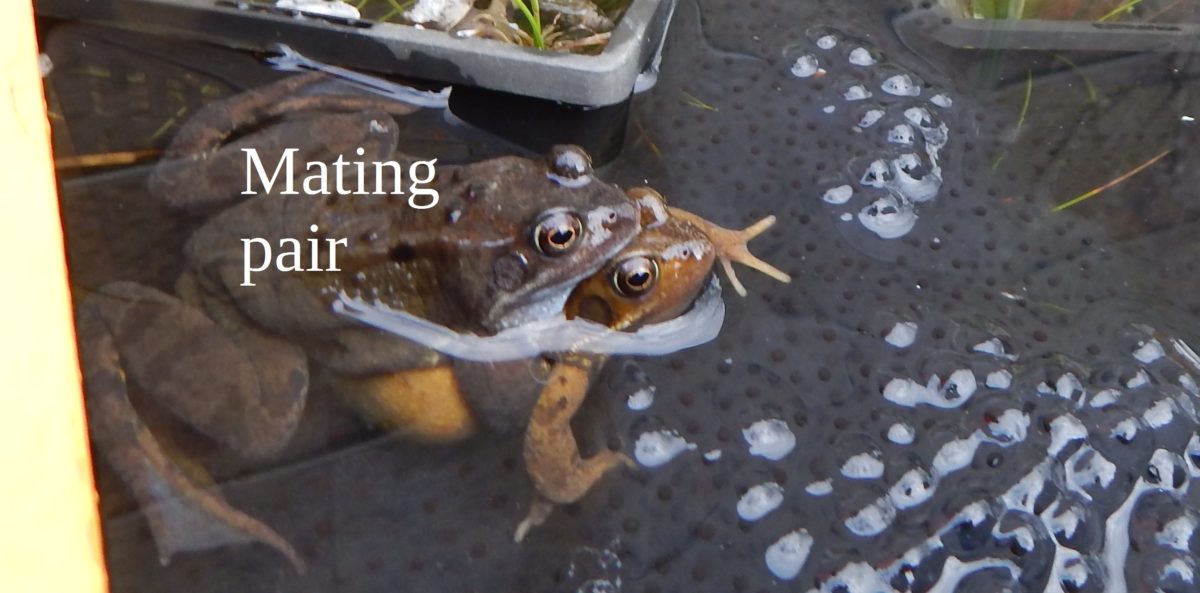I saw the first mating pair of frogs in our pond on 18 February. The male lays on the female’s back and grasps her, holding on for many hours. A breeding pair can be spotted by the two heads, his and hers, and you can see more legs than a single frog would have. She’s bigger than he is, especially so when stuffed with spawn. Fast forward, this is what is supposed to happen next: she releases her eggs, usually at night, and that triggers the male response and he sprays his sperm over them. Males do not have a penis but sperm floods out of his cloaca as she lays the eggs.
Except, no spawn was in the pond the next day. This surprised me, as I had thought that once mating began it followed through to a mass of frog spawn. I came in every day after that. On spawn watch.
On 22 February, I see another mating pair. But the next day, there was no spawn. I began to think, this must be commonplace. And I wondered why. I postulated that she is simply not ready to lay her eggs for some reason. With her laying would come a pheromone which triggers the male response. But not this time either.
Kevin and I saw four mating pairs on 29 February. Now surely, four pairs will deliver. A leap year, that would memorable. One pair at least would give us spawn. But I am getting pessimistic, and deservedly so, as there was no spawn to greet the first day of spring, 1 March. None on the 3 March either. That’s two weeks since I began my spawn watch. Quite a few mating pairs over the period, but nothing to show for it. I am beginning to feel like one of the camera crew in a David Attenborough nature programme, waiting endless for the orcas or seals or wolves. The crew have been there a month, and this is their last day of filming.
I think of the female frogs, full of spawn. It must be so uncomfortable, so heavy, so ultra full. And there’s plenty of males around. So what is going on?
On the 4 March, there’s no frog spawn, but I see another mating pair. And I think, so what? I have been seeing them for two weeks. But the next day, the 5 March, there is, at last, frog spawn. Hallelujah. A smallish patch by the right hand corner, facing the back stage. Bubbly, coalesced spheres on the surface of the pond with a black dot in the centre of each sphere. Much of the spawn is under water. At last. After 16 days of spawn watching, with plenty of mating pairs, we have what we have been waiting for. I am like a nervous father in the maternity ward.
The next day, there is more. I think. I am not totally sure as spawn expands in water, absorbing water. But this seems more than just expansion. I wish the frogs would be more considerate and lay the spawn in separate places, but you get what you get.
The next day, 7 March, there’s more spawn. This lot is below the surface. It will absorb water, and expand but not enough to bring it to the surface. I think that is done by the CO2 given off by the developing embryos as cell division takes place, followed by differentiation of cells that will become organs, muscle and gut. All of which takes energy, with C02 gas is given off as waste.
On 9th March, there are at least 8 frogs in the pond, though I see only one mating pair. But the water is murky, there’s lots of water weed, and light reflection off the surface makes it hard to see clearly. Most of those I see are males. Have the females finished laying?
A couple of days ago, I got a picture of a mating pair, but unusually they were at the surface of the pond. The only pair I have seen who have been. Over this period, I have been thinking, why so many mating pairs and no spawn. I have searched on line, but found no answers there. I believe it is down to the temperature of the water. There is a threshold temperature. The male will grip the female for many hours, for days even. It is night when most spawning takes place, but not if the pond is too cold. Slowly our pond water has been warming. I suspect, it needs to get above 8 degrees for the female to lay. Below that, the pair get torpid, and he releases her. They are cold blooded creature and need to be warm enough to breed.
Next year, if I do spawn watch again, I shall take the temperature of the water each day.

